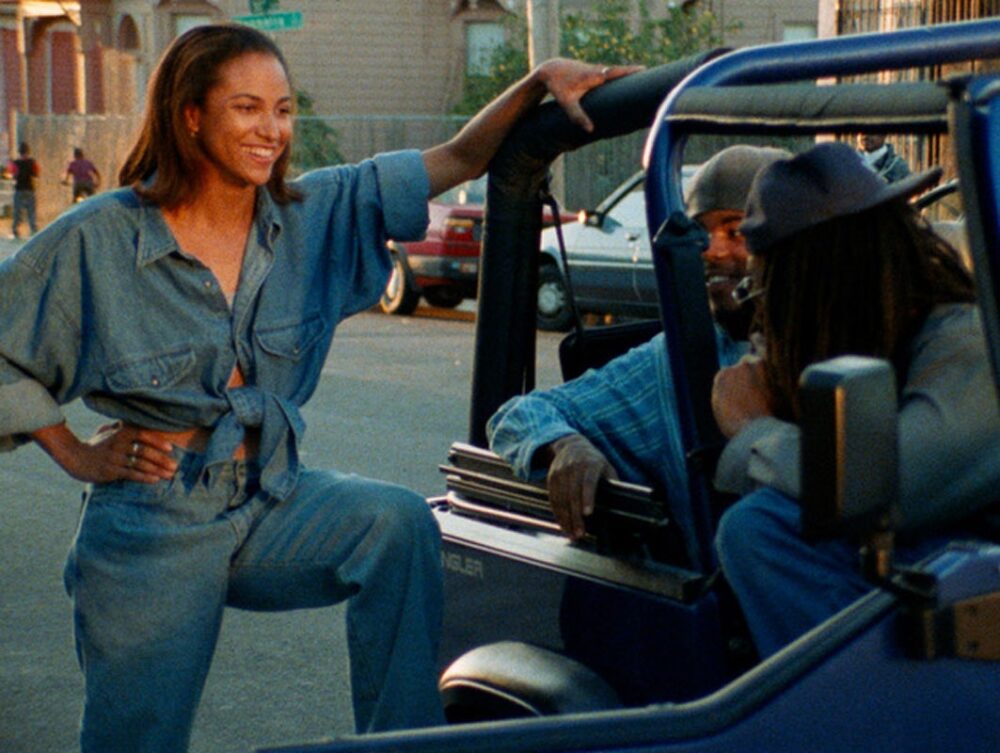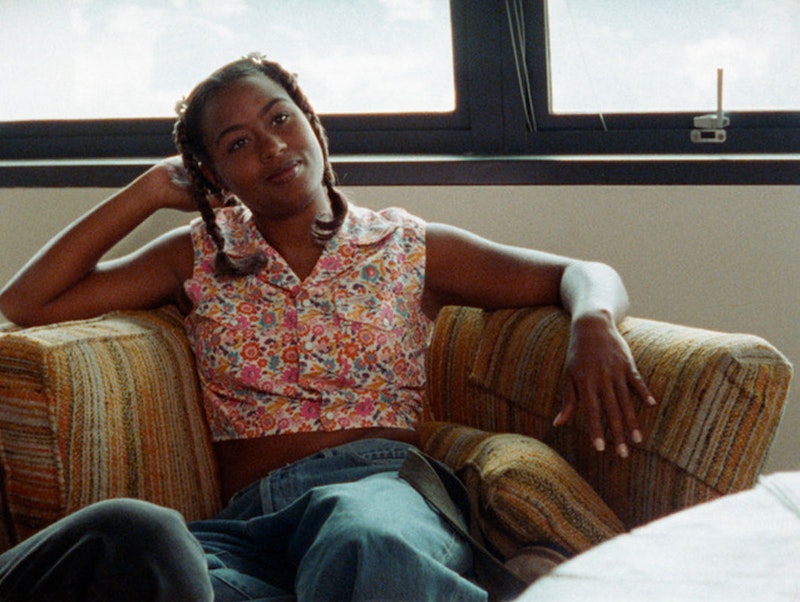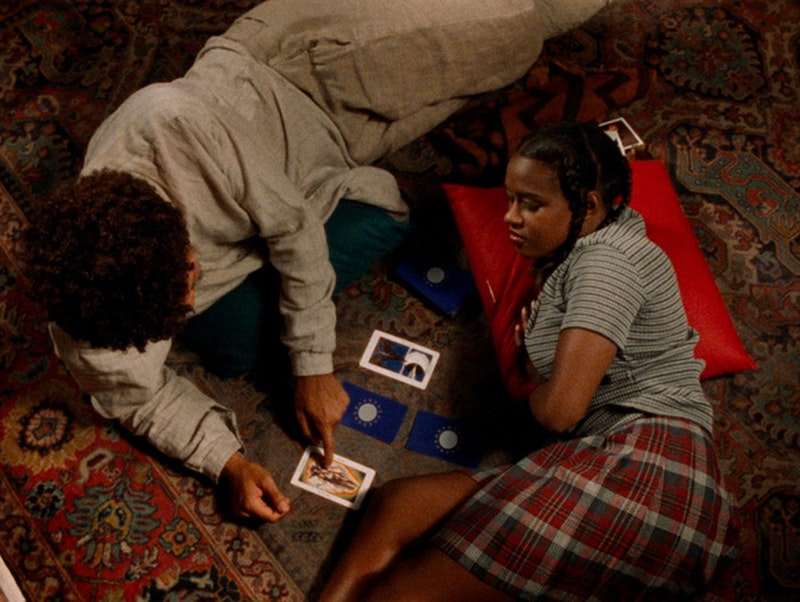
- Source: THE BROOKLYN RAIL
- Author: akané okoshi
- Date: MARCH 30, 2023
- Format: DIGITAL
Cauleen Smith with akané okoshi
Rail writer akané okoshi speaks with Cauleen Smith about her restoration of Drylongso.

April Barnett as Tobi in Cauleen Smith’s Drylongso (1998).
CAULEEN SMITH/JANUS FILMS
Shot on 16mm by interdisciplinary artist and filmmaker Cauleen Smith, Drylongso (1998) is a tender yet unflinching dispatch from 1990s Oakland. The film braids together a “buddy movie/murder mystery/romance” with, in Smith’s words, a “handmade veneer.” Smith’s first feature stars Toby Smith as Pica, an Oakland art student who photographs Black men in her community with a Polaroid camera in response to the alarming rate at which they perish. April Barnett plays Tobi, a woman fleeing an abusive relationship, with whom Pica forms a close kinship. The film, both in its community-rooted production and cinematic execution, traverses the potential of radical generosity and emblematizes the soul of the Oakland community.
Smith grew up in Sacramento, California. Based in LA and faculty member at UCLA School of Arts and Architecture, she continues to produce multimedia projects in the form of live audiovisual performances, short films, videos, installations, and more. Smith’s work has been featured in solo shows and group exhibitions at various institutions such as the New Museum, the Museum of Contemporary Art in Chicago, and LACMA. Smith was most recently recipient of the 2022 Heinz Award, the 2021 Guggenheim Fellowship, the 2020 Wein Artist Prize from the Studio Museum in Harlem, the Creative Capital grant, and a Black Metropolis Research Consortium Research Fellowship, among other awards. “Everything I make is just an offering,” explains Smith; “I think of my work as a contribution to the histories of the Black diasporas and our powers of invention, survival, and generativity.” Drylongso was filmed in the summer of 1995 and completed in 1998 when she was a student at UCLA’s school of Film, Theater, and Television. Through her imaginative labor, Smith captures an ethnography of Blackness that contends with how two Black women conjure love and light under the ongoing conditions of gratuitous violence in the 1990s. In anticipation of Drylongso’s restoration in collaboration with the Criterion Collection, Janus Films, and the Academy Film Archive, I had the pleasure of speaking with Cauleen Smith about restoring the film:
akané okoshi (Rail): What was the process of restoring Drylongso like?
Cauleen Smith: The first moments in the lab looking at the prints or even redoing the sound, it was really, actually painful because I had been thinking of this film as a failure, to be totally honest. Because of its reception, which actually was mixed, I got some really kind awards and accolades. But in terms of how it circulated or was supported by the industry—and in terms of what it led to regarding opportunities for me—it really was a failure and it didn’t rise. What I saw were all of the compromises I made every day on set to get something on film. It’s a lot when you have an inexperienced crew, maybe, or not enough money for enough crew, or people who really don’t understand that they have to show up at noon and not at three, otherwise we don’t get that scene. Stuff like that.
Every scene I’m recognizing those on-the-fly decisions that were painful, but now I really enjoy watching the film and recalling those decisions. The compromises are now the things that give the film its handmade veneer. If I had had all the support I needed it would not have had that. In fact, it is frightening to think of what it would have looked like or what it would have been like.

Toby Smith as Pica. Drylongso. Janus Films.
Rail: Can you speak to some ideas you are working out in Drylongso and how they have been taken up in your subsequent creations?
Smith: This was the nineties and death was everywhere. I don’t mean that nostalgically. Violence was just so mundane. People dying—young people dying—was so mundane that it was really confusing sometimes. One minute someone could be here and one minute they were not here, and it didn’t add up. That’s Pica’s central focus: this precarity and jeopardy of Black men. In her room you see Bob Marley posters, Marcus Garvey—it’s all of these patriarchal male figures. And Tobi comes with this—it’s a class issue also—comes with this exposure to things, particularly with my core obsession at the time, Lorna Simpson, whose work was crucial. Tobi brings this sort of Black feminist lens into the conversation and at moments you even see her and Pica clash on this. The mundaneness of violence at that time, it’s also a bitter irony. We are coming out of this opioid crisis and it seems to have been something that really affected working class white people, right? And all of a sudden addiction was a disease and people were people and they had stories and they had struggles. And in the nineties with crack, we were literally described as animals on the news routinely. The reporters who were describing the opioid crisis and doing stories about the humanity of these addicts were the same reporters who called us animals in the nineties. The same voices. And that kind of recognition of the way in which hip hop at the time acknowledged that we would never really be visible; there would be no recognition of humanity, and hip hop artists stopped attempting to aspire to that, which is why I really identify with hip hop culture, history, and philosophy even though I’m not a hip hop head but am a child of that culture and philosophy. And now we have all this language around death and Afro-pessimism and wake work—that I’m very grateful to have—to explain the experience of surviving those decades without that language… now we have a tangible conceptual object, an idea that we can talk about. But at the time, Pica and Tobi are working these things out in real time.
Rail: Please share a bit about the sound design for this film. Particularly regarding your choice of artists and the sound mixing.
Smith: The music was all gifted. Bay area hip hop artists gave me these tracks. In fact, I ran into one of those guys a few years ago and he didn’t even remember. I was like “I never got to thank you in person, thank you so much,” and he was like, “It’s all good, I liked the film. Congratulations…”
And that’s nineties hip-hop. Before there was money, there was heart, you know? When I’d get back footage and, like I said, it’s compromised (or at least that’s how I was thinking of it), I was like, “what can I do to make this one long shot of this empty lot have depth and presence?” I got really deep into sound effects and foley and ambiance and—considering this is 16mm film I’m editing, and the first cut is on a flatbed with electronic magnetic film—I moved into digital to do the sound. But it was a little bit crazy how carried away I got with the sound effects and building them. The best part of the restoration was being able to remix the sound. Because I didn’t have control over the previous sound mix. You’re supposed to, but my sound mix was free and I had a sound mixer who was a bit of a mansplainer, bless his heart, and he would just change things. I often could not get things how I wanted them. It was so great to be able to go back and do the mix with an empathic sound mixer and pull things out and enrich it.
Rail: What, in your view, constitutes a Black reliquary?

Will Power as Malik and Toby Smith as Pica in Cauleen Smith’s Drylongso (1998).
CAULEEN SMITH/JANUS FILMS
Smith: I love this question. I think Black artists have a long, long history of assemblage. I think assemblage actually comes out of, at least in the African American context and maybe Afro-Caribbean, a relationship with ritual objects in West Africa, a lot of binding and wrapping and combining of materials to make meaning. And using whatever is around and attaching that to something you can no longer access that you love. That’s what Wura-Natasha Ogunji was tapping into when she was making the sculptures that end up in the final scene or that Pica is building over the course of the film. She’s a fantastic artist still practicing, I’m sure you know. She’s amazing, based in Paris. I love this question because I never thought of those objects as Black reliquaries and yet that’s exactly what they are. Which points me to one of my other favorite artists, Paul Thek, and a lot of other artists. My mind’s kind of spinning because, woah yes, reliquaries, amazing. Thanks for that! I don’t even have a response because I’m processing how cool that is. So smart!
Rail: What are the best lessons from Drylongso you apply to your practice in filmmaking now?
Smith: The best thing about Drylongso was the way in which the community supported us. It wasn’t the plan. It wasn’t something that we consciously sought out, but it was clearly needed. I slept in the house we shot in every night. There was barely a lock on the door. All of the camera equipment was there. I was unharmed, completely safe. That is a decision a neighborhood makes to protect you. Every morning a bunch of kids—I would just call them the rugrats, because they wanted the bagels—these children were everywhere. You had to step over them to get into the house. There were just kids everywhere. Our crew just implicitly started involving them in making the film.
What I learned is that there is another way to make films that isn’t so much about a kind of conquering and colonizing of space. You can make a film inside of a community. And that community helped us make that film without us even asking. Imagine if you really did ask, what you could do. I still try to make work that way when I can. I will ask for things instead of trying to pay for them because I’m interested in the exchange beyond a monetary transaction. I’m interested in what they need or want. Or I’m interested in what would make them invested in what I need or want. And I didn’t know at the time that those were the most profound lessons I was learning from Drylongso.

